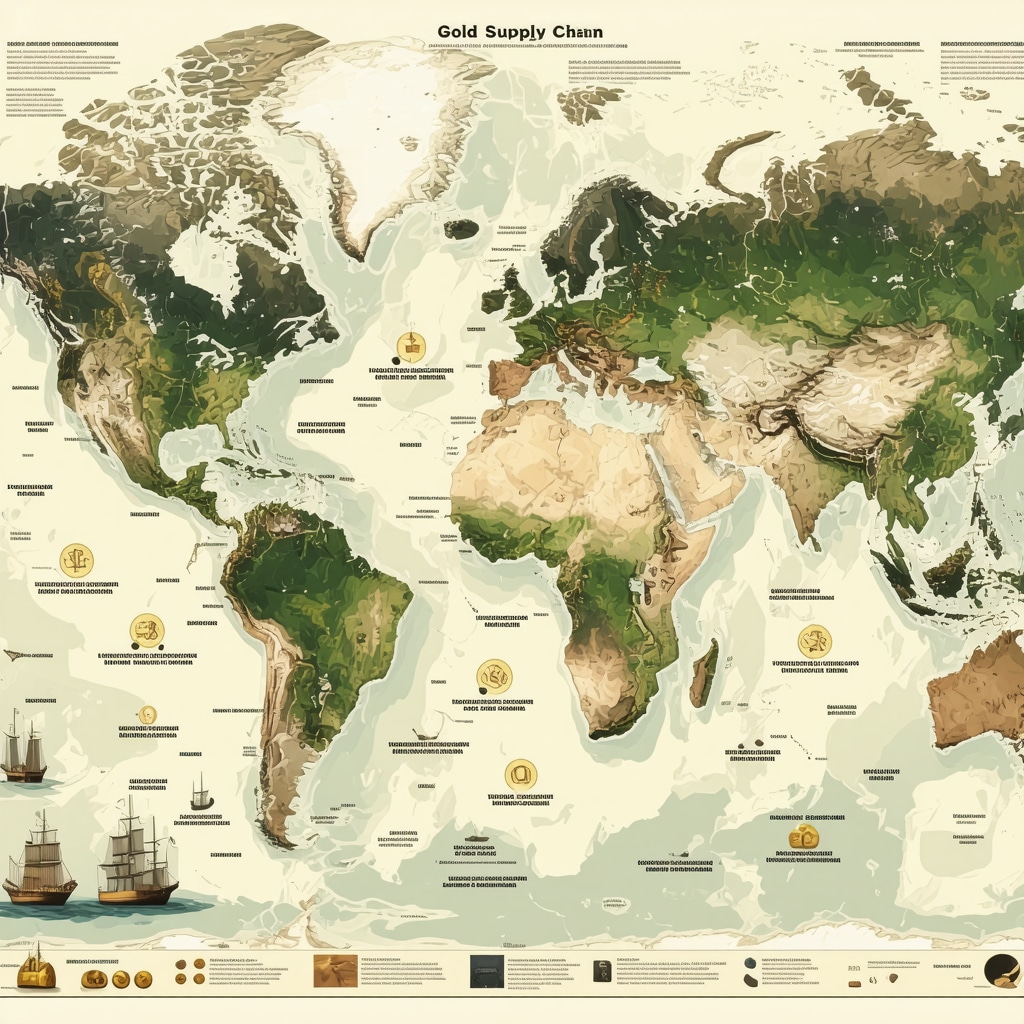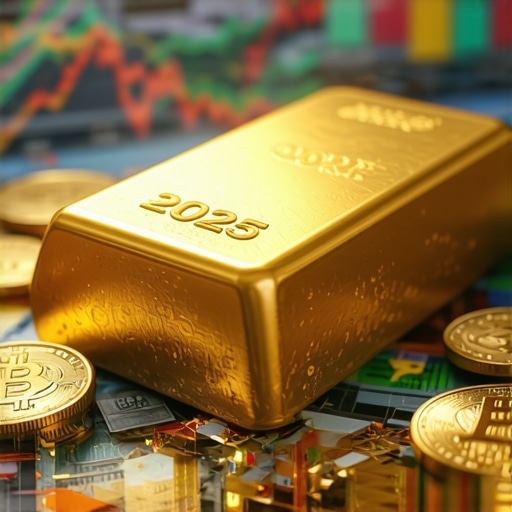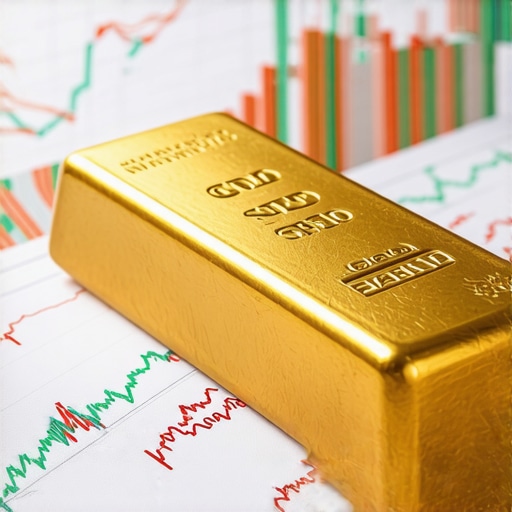Unlocking the Dynamics Behind Gold’s Market Movements
Gold has long captivated investors as a timeless store of value and a strategic hedge against economic uncertainty. Yet, beneath its shimmering allure lies a complex interplay of supply and demand forces that shape its price trajectory. For astute investors, grasping these trends is not merely academic—it is essential for making informed, smart investment decisions in 2025 and beyond.
Decoding the Supply Side: What Really Moves Gold Availability?
The global supply of gold is surprisingly inelastic in the short term. Mining output, which constitutes the primary source of new gold, faces geological, technological, and regulatory constraints that limit rapid production increases. For instance, recent years have seen marginal growth despite rising prices, as many major mines approach depletion or require significant capital to expand.
Recycling also plays a crucial role, accounting for roughly one-third of annual supply. As economic conditions shift, recycled gold flows fluctuate—higher prices encourage more recycling, but market disruptions can create bottlenecks. Additionally, central banks’ gold reserves and sales impact supply dynamics. In recent years, many central banks have transitioned from net sellers to net buyers, especially in emerging markets, reflecting strategic shifts in reserve diversification.
Demand Drivers: Beyond Jewelry and Investment
While jewelry remains a dominant demand pillar, especially in Asia, investment demand is evolving with market sophistication. Exchange-traded funds (ETFs), gold futures, and sovereign purchases increasingly influence demand volumes and volatility. Notably, industrial uses, though smaller, contribute to the demand mosaic, particularly in electronics and medical devices.
How Do Global Economic Trends Influence Gold Demand and Prices?
Economic uncertainty is a pivotal catalyst for gold demand. Inflationary pressures, currency volatility, and geopolitical tensions typically drive investors toward gold as a safe haven. For example, during periods of rising inflation in 2021-2023, gold demand surged globally, reflecting its role as an inflation hedge. Furthermore, interest rate policies by central banks impact gold’s opportunity cost; lower rates tend to boost gold appeal.
Regionally, Asia—especially China and India—continues to shape demand trajectories through cultural affinity and growing wealth. According to the World Gold Council, these markets are expected to maintain robust jewelry and investment demand, underscoring the importance of tracking regional consumption patterns for price forecasting.
Integrating Supply and Demand Insights for Strategic Investing
Smart investors blend supply constraints with demand evolution to anticipate price movements. For instance, limited mining growth combined with escalating demand from ETFs and central banks can create upward price pressure. Conversely, increased recycling or central bank selling might temper gains.
Understanding these nuanced trends supports portfolio diversification strategies, including physical gold investment, gold stocks, and derivatives. For a detailed guide on leveraging physical gold as a wealth preservation tool, explore best physical gold investment options.
Engage With Us: Share Your Experience and Insights
Have you noticed how recent shifts in gold supply and demand have impacted your investment decisions? Join the conversation by commenting below or sharing this post with fellow investors eager to deepen their market understanding.
Exploring Central Bank Gold Reserves: Strategic Trends and Market Impact
Central banks have become pivotal players in the gold market, not merely as custodians but as active participants shaping supply and demand. Their strategic accumulation of gold reserves serves multiple purposes, including diversification away from fiat currencies, hedging against geopolitical risks, and boosting national financial security. For example, in recent years, central banks in emerging economies such as Russia, China, and Turkey have aggressively increased their gold holdings, influencing global price trajectories.
This trend has important implications for investors. Central bank purchases tend to create a floor for gold prices, reducing downside risk and enhancing the metal’s appeal as a long-term store of value. However, sudden shifts in policy or reserve liquidation, though rare, can introduce volatility. Understanding these macro-level movements is crucial for anticipating market changes and calibrating investment strategies accordingly.
Gold Supply Chain Challenges: How Logistics and Geopolitics Affect Availability
While geological constraints limit mining expansion, supply chain factors also critically influence gold availability. Transportation bottlenecks, export regulations, and geopolitical tensions can disrupt the flow of gold from mines to markets. For instance, trade restrictions or sanctions on resource-rich countries can constrain supply, tightening global availability despite stable mining output.
Additionally, refining capacity and certification processes impact how quickly newly mined or recycled gold reaches investors. Delays in these stages can cause temporary scarcity and price premiums. Savvy investors monitor these operational nuances, as they offer early signals of supply-side pressures that may not be immediately apparent from production statistics alone.
Demand Diversification: Emerging Sectors and Their Growing Influence
Beyond traditional jewelry and investment demand, emerging sectors are incrementally shaping gold consumption patterns. The technology industry’s reliance on gold for high-performance electronics and medical devices is growing, albeit modestly relative to other demand sources. Innovations in nanotechnology and sustainable energy may further elevate gold’s industrial relevance, introducing new demand vectors.
Moreover, digital gold-backed assets and tokenization are gaining traction, bridging physical gold with blockchain technology. This evolution could democratize access and enhance liquidity but also introduces regulatory and security considerations. Investors should remain alert to these developments, as they may redefine demand composition and influence price behavior in nuanced ways.
Can Integrating Gold Market Insights Enhance Your Portfolio Resilience in Uncertain Times?
Given the multifaceted factors influencing gold markets—from central bank behaviors and supply chain complexities to emerging demand sources—how can investors effectively integrate these insights to bolster portfolio resilience? A strategic approach involves continuous monitoring of geopolitical developments, macroeconomic indicators, and technological trends, combined with diversified gold investment vehicles such as physical bullion, ETFs, and mining stocks.
For example, an investor might allocate capital across physical gold for stability, ETFs for liquidity, and select mining stocks for growth potential, balancing risk and reward. Incorporating gold into a broader asset allocation can mitigate volatility and provide a hedge against inflation and currency risk. Detailed strategies for building a balanced gold portfolio are available in resources like how to build a balanced portfolio with gold stocks and ETFs.
Expert Perspective: Authoritative Analysis on Gold Market Trends
According to the World Gold Council, an authoritative source in the gold industry, global demand trends are increasingly nuanced, reflecting shifts in economic power and consumer behavior. Their rigorous research highlights that while traditional drivers remain vital, emerging market dynamics and technological advancements are reshaping the gold landscape. Incorporating such expert insights enables investors to anticipate market shifts with greater confidence and precision.
Join the Expert Dialogue: Share Your Views and Expand Your Knowledge
We invite you to engage with this evolving conversation. How have these advanced factors influenced your gold investment decisions? Share your experiences and insights in the comments below, and consider sharing this article with fellow investors seeking to deepen their understanding of gold market complexities. For those eager to expand their expertise, explore our comprehensive guides such as gold demand trends in Asia and top gold trading techniques for 2025 to stay ahead in the dynamic gold investment landscape.
Central Bank Gold Reserves: Analyzing Strategic Accumulation and Its Ripple Effects on Global Markets
The strategic accumulation of gold reserves by central banks is not merely a passive act of diversification but a nuanced maneuver with profound implications for global liquidity and price stability. Central banks in emerging economies have aggressively expanded their gold holdings as a defensive hedge against dollar dependence and geopolitical risk. For example, Russia’s consistent gold purchases over recent years have contributed to a subtle but sustained upward trajectory in global gold prices, serving as a market signal of confidence in gold’s intrinsic value.
Yet, these central bank policies are far from uniform. Developed economies often balance gold reserves with other assets to optimize returns, while emerging markets may prioritize gold to insulate against currency volatility. The International Monetary Fund’s 2021 working paper highlights this asymmetry, underscoring how geopolitical tensions and monetary policy divergence amplify gold’s role as a reserve asset. Investors need to monitor these evolving central bank dynamics closely, as shifts in reserve accumulation or liquidation can precipitate significant market movements, impacting both short-term volatility and long-term price trends.
Supply Chain Complexities: Beyond Mining Output to Geopolitical and Logistical Constraints
While mining production remains a foundational supply factor, the gold supply chain encompasses intricate logistical and geopolitical variables that can cause unexpected scarcity or surpluses. For instance, export restrictions in major gold-producing countries, such as the tightening of export licenses in Ghana or political instability in South Africa, can create bottlenecks that restrict gold availability despite steady mine output.
Moreover, refining capacity is a critical chokepoint. Limited refineries with stringent certification standards delay the processing of newly mined or recycled gold, often leading to temporal premiums in the market. These delays are compounded by increased scrutiny for conflict-free sourcing and environmental compliance, which although essential for ethical investment, add layers of complexity and potential supply interruptions.
How Can Advanced Investors Anticipate and Mitigate Supply Chain Risks in Gold Investing?
Anticipating supply chain disruptions requires a multidimensional approach. Investors should track geopolitical developments in key mining regions, monitor regulatory changes affecting export and refining, and assess the health of secondary supply streams like recycling. Leveraging real-time trade data, satellite imagery of mining operations, and insights from industry reports can offer early warning signals.
Moreover, diversifying gold exposure—incorporating physical bullion, ETFs, and mining equities—can mitigate risks associated with supply chain bottlenecks. Investing in companies with vertically integrated operations or those positioned in geopolitically stable jurisdictions may further enhance portfolio resilience.
Emerging Demand Frontiers: Technology Innovations and Digital Gold Ecosystems Reshaping Consumption
Gold’s traditional demand drivers are being complemented and gradually transformed by innovative sectors. The medical field’s adoption of gold-based nanotechnologies for targeted drug delivery and diagnostics is expanding, introducing a novel industrial demand vector that, while currently modest, is projected to grow as technologies mature.
Simultaneously, the rise of digital gold-backed assets—cryptographically secured tokens representing physical gold holdings—has begun democratizing access to gold investments. This tokenization leverages blockchain’s transparency and liquidity, appealing to younger, tech-savvy investors and facilitating fractional ownership.
However, digital gold ecosystems face regulatory uncertainties and cybersecurity challenges, requiring investors to evaluate the credibility of platforms and custodians carefully. The interaction between physical gold markets and digital tokens may influence demand patterns and price dynamics in unprecedented ways, necessitating sophisticated analytical tools to navigate.
Leveraging Expert Gold Market Insights for Enhanced Portfolio Strategy
Integrating these complex supply-side nuances, central bank behaviors, and emerging demand trends enables investors to construct more resilient and adaptive gold portfolios. Employing advanced analytics—such as machine learning to model geopolitical risk impact or blockchain-based supply chain transparency tools—can provide a competitive edge.
Investors interested in deepening their understanding and accessing cutting-edge strategies are encouraged to explore authoritative resources like the World Gold Council’s detailed reports, which dissect global and regional demand in granular detail, and to participate in expert forums and webinars dedicated to gold investment innovations.
Understanding gold’s evolving landscape is not a static pursuit but a continuous journey requiring a blend of macroeconomic awareness, technological savvy, and strategic diversification. Stay engaged, keep learning, and refine your approach to harness gold’s full potential in your portfolio.
Decoding Supply Chain Vulnerabilities: Strategic Insights for the Discerning Investor
Beyond mining output, the gold supply chain is a labyrinth of logistical, geopolitical, and regulatory complexities that demand meticulous scrutiny. Investors with a sophisticated grasp recognize that disruptions—from export embargoes in resource-rich nations to bottlenecks in refining capacities—can abruptly constrict gold availability, triggering transient price surges. The interplay between environmental compliance standards and certification protocols further compounds these challenges, necessitating proactive monitoring of evolving policies and operational metrics within key jurisdictions.
How Can Advanced Investors Anticipate and Mitigate Supply Chain Risks in Gold Investing?
Effectively forecasting supply chain disruptions requires leveraging multifaceted data sources including satellite imagery of mining activities, real-time trade analytics, and geopolitical risk assessments. Strategic diversification across physical bullion, ETFs, and mining equities—particularly those with vertically integrated operations or domiciled in geopolitically stable regions—serves as a robust hedge against localized supply shocks. Additionally, engaging with industry intelligence platforms and subscribing to expert market reports enhances anticipatory capabilities, enabling nimble portfolio adjustments ahead of market perturbations.

Emerging Demand Frontiers: Harnessing Technological Innovation and Digital Transformation
The paradigm of gold demand is evolving rapidly as cutting-edge technological applications and digitization reshape consumption patterns. From burgeoning uses of gold-based nanotechnologies in precision medicine to the ascent of blockchain-enabled digital gold tokens facilitating fractional ownership and liquidity, these trends herald a transformative era. While regulatory and cybersecurity challenges persist, the convergence of physical and digital gold markets introduces novel dimensions of investor engagement and market dynamics.
Harnessing Authoritative Insights: A Gateway to Strategic Gold Investment
For investors aiming to master this intricate landscape, authoritative research is indispensable. The World Gold Council provides exhaustive analyses on global demand trajectories and supply nuances, empowering investors with data-driven perspectives essential for forecasting and risk management. Integrating these insights with advanced analytical tools—such as machine learning models evaluating geopolitical and market signals—can substantially elevate investment acumen and portfolio resilience.
Engage with the Cutting Edge: Elevate Your Gold Investment Strategy Today
Are you ready to navigate gold’s complex ecosystem with enhanced precision and foresight? Dive deeper into multifactorial analyses and join a network of expert investors exploring innovative strategies. Share your experiences and questions in the comments below, or connect via our exclusive webinars and forums dedicated to gold investment mastery. Transform your approach and capitalize on gold’s evolving potential in a dynamic global market.
Frequently Asked Questions (FAQ)
What factors primarily influence gold prices in the short and long term?
Gold prices are driven by a blend of supply-side constraints such as limited mining growth and recycling rates, and demand-side factors including investment flows, jewelry consumption, central bank purchases, and emerging industrial applications. Macroeconomic variables like inflation, interest rates, currency fluctuations, and geopolitical tensions also play crucial roles. In the short term, market sentiment and liquidity can cause volatility, while long-term trends reflect structural supply-demand balances and strategic reserve accumulation.
How do central bank gold reserves impact global gold markets?
Central banks influence gold markets by strategically accumulating or occasionally liquidating reserves to diversify portfolios and hedge geopolitical risks. Their buying creates a price floor and signals confidence, often driving sustained price appreciation, especially when emerging economies increase holdings. Conversely, unexpected selling can introduce volatility. Monitoring central bank actions provides insights into macro-level demand and potential market inflection points.
Why is gold supply considered inelastic, and what constraints limit mining growth?
Gold supply is inelastic because mining expansion faces geological limitations, high capital expenditure, long development timelines, and regulatory hurdles. Many major mines are mature or nearing depletion, and environmental compliance adds complexity. Recycling supplements supply but fluctuates with price incentives and market conditions. These factors prevent rapid supply increases despite rising demand or prices.
How do geopolitical and logistical factors affect gold availability?
Geopolitical tensions, trade restrictions, export regulations, and political instability in key mining regions can disrupt gold supply chains, causing bottlenecks and temporary scarcity. Refining capacity constraints and strict certification processes further delay supply. These operational challenges can inflate prices transiently and add unpredictability beyond raw mining output data.
What emerging sectors are influencing gold demand beyond traditional uses?
Emerging demand arises from technological innovations such as gold-based nanotechnologies in medicine, advanced electronics, and sustainable energy applications. Additionally, digital gold ecosystems—tokenized gold assets on blockchain platforms—are democratizing access and liquidity. While currently smaller in scale, these sectors are expected to grow, reshaping consumption patterns and investment dynamics over time.
How can investors mitigate risks associated with gold supply chain disruptions?
Investors can mitigate supply chain risks by diversifying holdings across physical bullion, ETFs, and mining stocks, especially those with vertical integration or operations in geopolitically stable regions. Utilizing real-time geopolitical monitoring, trade analytics, and industry intelligence platforms enhances anticipatory capabilities. Strategic portfolio adjustments based on these insights help manage localized shocks and maintain resilience.
What role do macroeconomic trends like inflation and interest rates play in gold demand?
Inflation erodes fiat currency value, boosting gold’s appeal as an inflation hedge. Low or negative real interest rates reduce the opportunity cost of holding gold, increasing demand. Conversely, rising interest rates can dampen gold attractiveness by enhancing returns on alternative assets. Economic uncertainty and currency volatility often drive safe-haven buying, making gold a strategic asset during turbulent times.
How are digital gold-backed assets changing traditional gold investment?
Digital gold tokens enable fractional ownership, enhanced liquidity, and broader accessibility through blockchain technology. They offer transparent, real-time trading but introduce regulatory and cybersecurity risks. These assets complement physical gold holdings and may alter demand composition, requiring investors to balance innovation benefits with due diligence on platform credibility and custodial integrity.
Can integrating advanced analytics improve gold investment outcomes?
Yes, leveraging advanced tools like machine learning to analyze geopolitical risks, supply chain data, and market signals can provide a competitive advantage. These analytics help forecast price movements, identify early warning signs of disruptions, and optimize portfolio allocations. Combining data-driven insights with expert knowledge fosters more informed, adaptive investment strategies.
What strategies exist for building a balanced gold portfolio?
Effective strategies involve diversifying across physical gold for stability, ETFs for liquidity, and mining equities for growth potential. Investors should align allocations with risk tolerance, market outlook, and investment horizon. Incorporating emerging demand trends and supply-side insights enhances portfolio resilience. Continuous education and monitoring are essential for timely adjustments.
Trusted External Sources
- World Gold Council (https://www.gold.org/): As the leading authority on gold market research, it offers comprehensive data and analysis on global supply, demand trends, and investment insights, essential for informed decision-making.
- International Monetary Fund (IMF) Working Papers (https://www.imf.org/en/Publications/WP): Provides rigorous economic research on central bank gold reserve strategies and their macroeconomic impacts, helping investors understand geopolitical and monetary policy influences.
- London Bullion Market Association (LBMA) (https://www.lbma.org.uk/): Offers critical information on gold refining standards, certification processes, and market infrastructure, crucial for assessing supply chain integrity and ethical sourcing.
- Metallurgical and Mining Industry Journals (e.g., Minerals Engineering): Deliver technical insights into mining production challenges, technological advances, and environmental compliance affecting gold supply dynamics.
- Specialized Financial Analytics Platforms (e.g., Bloomberg Terminal, Refinitiv): Provide real-time geopolitical, trade, and market data analytics, enabling sophisticated risk assessment and portfolio management.
Conclusion: Mastering Gold Market Complexities for Strategic Investment
Understanding gold’s intricate market dynamics requires a holistic approach that synthesizes supply constraints, evolving demand drivers, central bank strategies, and emerging technological innovations. The metal’s inelastic supply, shaped by geological and logistical challenges, combines with diverse demand—from traditional jewelry and investment to cutting-edge industrial and digital applications—to influence price trajectories profoundly.
Central bank reserve policies and geopolitical developments add layers of complexity, underscoring the necessity for vigilant monitoring and advanced analytics. By integrating these multifactorial insights, investors can craft balanced, resilient portfolios that leverage gold’s unique attributes as a hedge against inflation, currency risk, and economic uncertainty.
We encourage readers to deepen their engagement by exploring authoritative research, adopting sophisticated investment tools, and participating in expert dialogues. Share your perspectives, comment with your experiences, and explore related expert content to unlock gold’s full potential in your investment strategy today.










This post expertly captures the multifaceted nature of gold investing, especially the crucial balance between supply constraints and emerging demand trends. What struck me most is the significance of central banks shifting from net sellers to net buyers. In my experience, this strategic accumulation by emerging markets has helped stabilize prices, providing a buffer during volatile periods. However, I’ve also noticed that the inelasticity of gold supply, due to mining and recycling limitations, makes sudden price spikes more common when demand surges unexpectedly. This creates both opportunity and risk for investors. I’m particularly intrigued by the evolving role of digital gold-backed assets and how they might democratize access while introducing new regulatory challenges. For those actively investing, how are you factoring in these technological advancements alongside traditional physical gold and ETFs? Also, given the geopolitical and logistical hurdles impacting gold supply chains, do you prioritize certain types of gold investments to mitigate these risks? I believe diversifying across physical bullion, ETFs, and mining stocks—as suggested—offers resilience, but I’d love to hear how others adjust their strategies in response to these nuanced market forces.
Elena, you raised insightful points about the evolving gold market, especially the strategic moves of central banks and the challenges tied to supply inelasticity. From my perspective, one of the most intriguing aspects is how the interplay between constrained mining output and fluctuating recycling rates creates a delicate balance affecting price stability. I’ve observed that in regions where geopolitical tensions increase export restrictions, investors tend to lean more heavily on ETFs and gold-backed digital tokens to maintain liquidity and flexibility. Regarding your question about integrating technological advances, I see digital gold assets as a complementary tool rather than a full replacement for physical holdings—primarily because the regulatory environment for tokens is still maturing, and security concerns persist. To mitigate geopolitical and logistical supply chain risks, I’ve diversified by choosing mining companies with operations in politically stable jurisdictions and those with vertically integrated refining processes. This approach has helped me weather occasional supply shocks better than pure physical bullion holdings alone. I’m curious if others have found value in employing real-time geopolitical analytics or satellite data to anticipate disruptions before they hit the market? How do you balance the trade-offs between the perceived stability of physical gold and the agility offered by digital or ETF instruments in supply-constrained times?